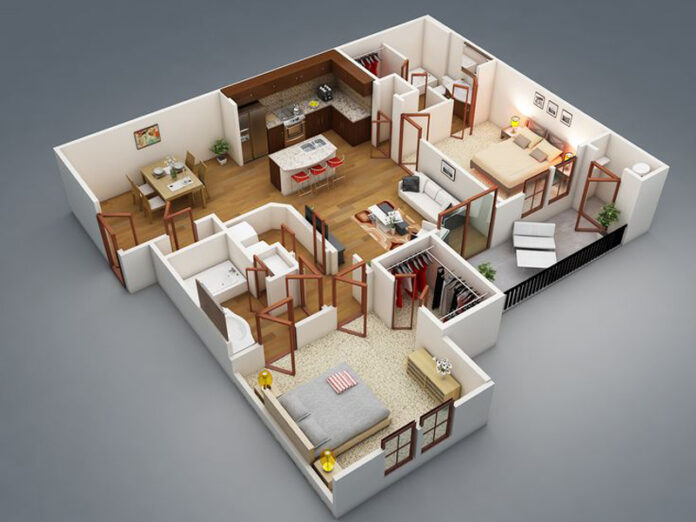Home sweet home. It’s where we head when the long day is done. We relax, make our meals, and do what we want to do, such as looking at our computer for our SNDL stock forecast. We love our place and how we have decorated it. Going back to the days of the caveman, humanity has always created and decorated its surroundings. It is a natural process called homeostasis, and it makes us feel better when we are in a comfortable living space.
Home decor terms can be used interchangeably with interior design terms, and they both mean the same thing: how you set up your living spaces. There are some general rules, but everyone does what suits them best.
Let’s Discuss the Differences
Traditional decor refers to traditional furniture, colors, and overall design. For example, this style usually uses dark woods, chandeliers made out of antlers, warm paint colors like terracotta or aubergine (eggplant) or soft blues, velvet furniture, and large rugs in the living room.
Modern decor is all about how it looks; sleek lines are everywhere in modern decorating. This includes straight lines on walls with few embellishments aside from paint color(s). Colors are also neutral (white/gray/black). Simplicity is key for this style because there’s no clutter or anything that will make the space look smaller than it already is. Modern doesn’t necessarily mean cold; there can be some warmth to the room with a statement piece and splashes of color.
The industrial decor has an edgy look, but it’s still very rustic. The materials used in this style can be expensive-looking because they’re put together (like refurbished wood furniture). However, it’s still all about using natural materials as much as possible. You’ll see plenty of wooden accents mixed with metal, especially for lighting and accessories like wall sconces and shades. This is mainly done for architectural purposes rather than decoration, but if contrasting elements don’t necessarily match then, that’s pretty ideal for industrial design concepts. The main idea behind this style is incorporating rough textures into anything you’d use in your home, for example, wooden beams on the ceiling mixed with exposed brick and rusty metal.
Bohemian decor is a colorful style inspired by nature, vintage flair from other cultures (like Morocco or India), and anything artsy and “hippie” in general. You’ll see rich colors all over the place without it looking overwhelming. This style also uses organic materials like rattan furniture, marble tables topped with floral arrangements, and wicker baskets to add natural elements into a space while still having a sense of luxury. Lighting is usually rustic-style chandeliers or lanterns, while wall art can include tapestries or something like oil paintings framed in reclaimed wood frames.
Contemporary decor is very minimalist; you won’t find any clutter in this style. There will be little to no curiosities, if not none at all. Furniture pieces are usually modern (think sleek lines & neutral colors), but the contemporary design will also use more natural materials like rattan or wood. It’s really about the contrast between these two styles, which is where the name comes from (“contemporary” refers to anything “modern”). The color palette would consist of white walls, dark accents like black woods and leather furniture, plus splashes of light colors for things like vases or paintings/prints on the wall. Lighting is minimal because there’s just the right amount of light, so it doesn’t look dull.
The rustic decor uses earthy tones with lots of woods, notably rustic red bricks and weathered driftwood. Natural elements like stones and pebbles should be present as well. You’ll see less conventional materials for furniture or other accents; these could include reclaimed wood and vintage pieces, so it’s good if you have a unique style to pull off this look easily. Lighting is usually functional (like floor lamps) instead of decorative due to the organic nature of the decor. Iron and brass will be seen here, too, especially those that are aged or rusty looking.
Home Decor Facts
1) Traditional homes were designed by architects, who created specific guidelines for what type of material can go where depending on what room it is.
2) As time went on and society became more progressive, home decor became about making a space more livable and comfortable instead of what was “proper” according to the status quo. People didn’t mind if their furnishings went against traditional aesthetics so long as it felt pleasant to be in that space.
3) Modern architecture is mainly known for being built with steel and glass structures. Mid-century modern design was inspired by movements like Bauhaus, which emphasized streamlining a room’s function all while making sure everything still looks beautiful.
4) Industrial spaces will always have a lot of metal and sometimes even brick masonry incorporated into the design because they’re durable materials that can stand up well under heavy use. In terms of cost, this style tends to be more expensive than others since they require a lot of work to get right.
5) When decorating with a theme, it’s important to have a clear picture in mind to know what types of elements you want. This makes the process much easier because if your goal is to add art that reflects another country’s culture, you’ll only be browsing through that category when shopping for things like rugs or bed sheets. Home decor can be used for adding personality to your style instead of just being an afterthought.
In conclusion, traditional decor is best used for formal rooms like living rooms and libraries. Contemporary & modern styles are better for spaces like offices and even bedrooms (although it can be risky if you want your bedroom to look serene instead of busy). Rustic settings should be reserved for casual rooms like family or game rooms, and industrial spaces should only use that style as long as it fits the vibe and not clash with other designs.












